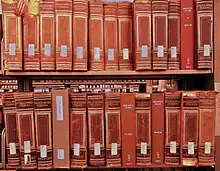 | |
| Country | Italy |
|---|---|
| Language | Italian |
| Genre | Encyclopedia |
| Publisher | Treccani |
Publication date | First published serially between 1929 and 1936 |
| Media type | |
| Website | www |
| This article is part of the series on the |
| Italian language |
|---|
| History |
| Literature and other |
| Grammar |
| Alphabet |
| Phonology |
The Enciclopedia Italiana di Scienze, Lettere e Arti (Italian: "Italian Encyclopedia of Science, Letters, and Arts"), best known as Treccani for its developer Giovanni Treccani and also as Enciclopedia Italiana, is an Italian-language encyclopaedia, regarded as one of the great encyclopedias, being international in scope, alongside the Encyclopædia Britannica and others.[1]
History
The Institute of the Italian Encyclopedia was founded in Rome in 1925 by Giovanni Treccani, and philosopher Giovanni Gentile was chosen editor-in-chief. The first edition was published serially between 1929 and 1936.[2] The encyclopedia's 35 volumes (plus one index volume) included 60,000 articles and 50 million words.[3] Each volume is approximately 1,015 pages, and 37 supplementary volumes were published between 1938 and 2015. The redactor-in-chief was Antonino Pagliaro.
Most of the articles are signed with the initials of the author. An essay credited to Benito Mussolini entitled "The Doctrine of Fascism" was included in the 1932 edition of the encyclopedia, although it was ghost-written by Gentile.[4]
The articles are now available online for free.
See also
References
- ↑ Collison, Robert (1964). Encyclopaedias: Their History Throughout The Ages. New York & London: Hafner Publishing Company. p. 207.
- ↑ "Enciclopedia italiana di scienze, lettere ed arti". Archived 28 May 2008 at the Wayback Machine. Encyclopædia Britannica. (2007)
- ↑ Treccani Degli Alfieri, Giovanni. "Enciclopedia italiana" Diccionario Literario (Hora, S.A., 2001)
- ↑ Kraus, Carl; Obermair, Hannes (2019). Mythen der Diktaturen. Kunst in Faschismus und Nationalsozialismus – Miti delle dittature. Arte nel fascismo e nazionalsocialismo. Landesmuseum für Kultur- und Landesgeschichte Schloss Tirol. pp. 56–57, with facsimile of the article. ISBN 978-88-95523-16-3.